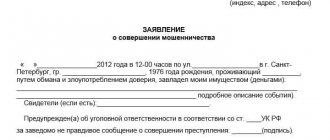Who needs it
Lending money to a relative or making an advance payment under an agreement - all these operations involve the transfer of funds from one person to another.
To avoid conflicts in the future, figure out how to write a receipt for receiving funds correctly, and use this knowledge in practice. This is not always necessary, but what if one of the parties refuses to fulfill its obligations? For example, a relative will brush you off with the words that he did not occupy anything. And the company will again demand an advance payment for future deliveries, omitting the fact of making an advance payment in cash. In such situations, you will have to prove your case through court, and this is long and expensive. It is much easier to worry about yourself in advance and draw up a supporting document. It is recommended to indicate on what terms the loan was issued (interest-free or with interest).
IMPORTANT!
If money is lent and if one of the parties (or both) is an organization, then preparing only a receipt for receipt of money is not enough. In such a situation, you will have to draw up a loan agreement (Articles 807-811 and 814 of the Civil Code of the Russian Federation).
Legal force
The concept of “receipt” is enshrined in acts, but is most often found in laws when it comes to loans. Whatever the purpose of the transfer of funds specified in the receipt, it will have legal force. For a receipt to be valid, it must be properly drafted. The document must indicate the details of the owner and tenant, the amount, the purpose of the transfer, the date and period for which the amount was transferred.
A prerequisite for the legal significance of a receipt is the signatures of the parties to the transaction with a transcript and the absence of corrections.
It is not necessary to have the document certified by a notary , since it already has legal force. Notarization has one advantage: before signing the paper, it verifies the identity of the recipient of the funds, which will subsequently make it possible to easily prove that the document bears his signature.
Legal status of the document
It is easier to draw up the paper right on the spot, by hand - this is a simple form of receipt. If a serious transaction is being made and it is planned to transfer a fairly large amount, then it is recommended to carry out the procedure in the presence of a notary.
However, both documents are endowed with legal force: both a receipt signed by a notary and a form filled out manually by the parties. Of course, notarization increases the status of the paper. In simple words, if a dispute arises regarding the transfer of money, a notary will act as a witness to the circumstances.
When drawing up a simple written form in the event of a dispute, the authenticity of the document is confirmed by conducting a special examination. And this takes quite a lot of time. But notarization is not a requirement.
Registration requirements
There is no strictly established form for the receipt. Allowed :
- drafted by hand (blue ink);
- printed version.
Lawyers recommend the first method of registration, since in this case it is easier to establish the validity of the document - you can conduct a graphological examination. Design tips :
- the text must be legible;
- any blots or corrections are unacceptable;
- information about the parties to the transaction must match what is written in the passport.
The paper is compiled in any form. For it to have legal significance, it is necessary to comply with the requirements for the content of the text, which will be discussed below. If payment is made in cashless form, then no document confirming the transfer of money is required.
The fact of transfer of funds in this case can be proven by bank account statements. To ensure greater security, the tenant can indicate the purpose of the transfer in the comments to the payment transaction. For example, “for paying for an apartment to Ivanov A.A. for May 2017."
Compilation rules
If you decide to complete the transaction through a notary, then you don’t need to worry about how to draw up this document. An employee of a notary office will independently prepare all the necessary papers, register the transaction in state accounting registers and issue special forms.
Questions arise when filling out the form yourself. It is permissible to use a receipt form, entering the necessary details and conditions into it, or draw up a document yourself.
Instructions on how to correctly draw up a receipt for the transfer of money from one person to another:
1. Place and date. First of all, indicate the place and time of drawing up the document. The place is the locality in which the transfer of funds takes place, and the time is the date. For example, indicate: “Samara city 03/12/2020”.
2. Information about the parties to the transaction. Disclose the information one by one: first indicate the details of the person issuing banknotes, then write down the details of the recipient (see at the end of the article). What information to disclose depends on the status of the parties.
If one of the parties is an individual, then enter his full name in the receipt template. fully. Then write down your passport details or details of another document proving your identity. If the party is an individual entrepreneur, then add his TIN and OGRNIP to the details.
If the participant in the transaction is a legal entity, then indicate:
- last name, first name and patronymic of the head of the company;
- job title;
- full name of the legal entity;
- TIN, OGRN of the organization.
If the party is an authorized representative, enter:
- his last name, first name, patronymic;
- passport or other identification document details;
- date and number of the power of attorney;
- information about whose interests the representative is acting in.
3. Now write down how much you are transferring, indicate in what currency the transaction is being made. Indicate the amount not only in numbers, but also in words. Use this option to indicate the amount: 120,000 rubles (one hundred twenty thousand rubles 00 kopecks).
4. Include information about the grounds and obligations. Describe in detail the basis on which money is transferred from one party to the other. For example, transferring an amount into debt, receiving a loan from an employer. Also describe what obligations each party assumes when making a transaction: the borrower undertakes to repay the debt within ____ calendar months. In this case, specific dates and deadlines for return must be indicated.
5. Additional terms of the transaction (optional: used if necessary). Indicate the purpose for which the money is transferred: to buy a car or to pay for treatment. They provide for the amount of payment for the use of borrowed capital - this condition is not mandatory, but is often used. Specify: the borrower agrees to repay 100,000 rubles plus a use fee of 1,000 rubles.
They also determine the rules for the return of money or establish the procedure for offsetting the advance received. It will not be superfluous to describe the responsibilities of the parties and the procedure for resolving disputes.
The finished document is signed by the borrower - the recipient of the money. By this he personally assures that he received the money. The completed receipt in one copy is kept by the lender and is confirmation of the fact of transfer of banknotes or goods.
How to write a receipt correctly
“Write a receipt”, “only against signature”, “give a receipt, and no problems” - how often do we hear these words. But we don’t always realize that it’s not enough just to give or receive a receipt. It still needs to be compiled correctly.
A few words about the receipt, its originator and recipient
The term “receipt” is familiar to many people. However, the legislation does not contain its official definition. The dictionary interprets the concept of “receipt” in the following meanings:
- a document with a signature certifying the receipt of something, confirming that the person who issued it received something as a loan;
— a safe receipt indicating that some value has been accepted for storage, etc.;
- a written act by which the creditor confirms the fulfillment of the obligation assumed by the debtor.
Usually a receipt is given to confirm:
- receiving something, for example, a deposit, borrowed money, alimony for a certain period, property for use.
Note! By giving or borrowing money, you are entering into a loan agreement. If its amount is 10 BV or more, the loan agreement must be drawn up in writing. In this case, the receipt is a confirmation of the loan agreement and its terms <*>.
Reference information The size of the BV is 27 bel. rub. <*>. Accordingly, the tenfold size of the BV will be 270 bel. rub. (27 x 10);
- acceptance of any thing for storage;
— fulfillment of an obligation assumed by another person.
As a rule, the receipt is written by the one who takes money, property, or confirms the fulfillment of an obligation assumed by someone. This person is the originator of the receipt.
The originator transfers the receipt to the person who gives him money, transfers property, etc., that is, to the recipient of the receipt.
The recipient of the receipt accepts it and keeps it for safekeeping until the originator of the receipt fulfills the accepted obligation (for example, repayment of a debt).
Example Situation 1. A neighbor borrowed your laptop. To protect yourself from unnecessary worries, you asked him to write a receipt and indicate in it that he undertakes to return the laptop to you in two weeks. He did this and then gave the receipt to you for safekeeping. In this situation, the neighbor is the originator of the receipt, and you are its recipient. Situation 2. A friend asked you to take a TV and refrigerator for storage while his apartment is being renovated. You did him a favor and agreed. True, an acquaintance, just in case, asked you to write a receipt about what things and in what condition you accepted from him. In this case, you are the originator of the receipt, and your friend is its recipient.
Contents of the receipt
The receipt is usually drawn up in any form. It is recommended to include the following information:
- document's name;
Example “Receipt for receipt of deposit”, “Receipt for acceptance of valuables for safekeeping”
— date and place of drawing up the receipt;
Example “February 11, 2021, Grodno”
— Full name, date of birth, passport details, place of registration and place of actual residence of the originator of the receipt, its recipient, as well as witnesses (if any).
Note! The passport must be valid at the time of writing the receipt;
- the fact of accepting money or other things. So, if the maker of the receipt borrows money, receives a deposit, etc., a certain amount of money (in numbers and in words) and the type of currency should be indicated. For example, 100 (one hundred) US dollars.
Note : It is advisable that the receipt read “received an amount in the amount of...”, “borrowed an amount in the amount of... the money was received by me in full.” Otherwise, it will be almost impossible to prove that the money was transferred to the originator of the receipt. Especially if he states that the recipient of the receipt promised to give them to him on another day, but did not keep his word.
If the originator of the receipt accepts the storage or temporary use of any property, this fact should also be recorded. In this case, it is desirable that the receipt describes the item being accepted, i.e. its brand, model, color, dimensions, presence or absence of defects are indicated;
Example Situation 1. A recent acquaintance borrowed an expensive camera from you while traveling abroad. You asked him to write a receipt about this. However, the receipt did not indicate the model of the camera or its condition. Upon returning from a trip, an acquaintance returned your camera with a broken lens, saying: “You gave me this.” It will be difficult to prove that you gave him the item in good condition and he ruined it. Situation 2. You are planning a long trip and need a laptop for work. However, yours is under repair. You borrowed a laptop from a colleague, made a receipt for it, but did not indicate that there was a large crack on the lid of the laptop. When you return it, your colleague may accuse you of damaging his property and demand that you repair the laptop at your expense or even buy a new one because you broke this one.
- the obligation of the maker of the receipt to return a certain amount of money, a specific thing, if something was transferred to him on credit, for use, or for storage. If a receipt confirms the fulfillment of an obligation assumed by another person, it is advisable to indicate in it the extent to which the obligation was fulfilled and its result (if possible);
- deadline for return of money and property;
- the amount of interest for the use of money and the period for their payment, if they are provided (when transferring money as a loan);
- place to return money and items. Especially if the originator of the receipt lives in another locality;
- the signature of the originator of the receipt and its transcript, as well as the signatures of witnesses (if any).
An example of the wording of a receipt for debt repayment: “Receipt February 11, 2021, Minsk, Petrov Petrovich, born May 18, 1986, passport: series MR 1000001, issued May 29, 2016 by the Leninsky District Department of Internal Affairs of Minsk, registered and residing at the address: Minsk, st. Sinaya, 6, apt. 12, borrowed from Nikolay Nikolaevich Nikolaev, born on August 22, 1950, passport: series MR 1000002, issued on August 24, 1995 by the Oktyabrsky District Department of Internal Affairs of Minsk, living at the address: Minsk, st. Sokola, 12, apt. 97, the amount of money in the amount of 210 (two hundred ten) Belarusian rubles. I received the money in full. I undertake to return the specified amount in full no later than May 1, 2021. Signature /P.P.Petrov/"
Recommendations for drawing up a receipt
The legislation does not contain requirements for drawing up a receipt. However, the recipient of the receipt to adhere to the following recommendations:
- Be sure to make sure that the receipt is signed by its originator.
Note: It is advisable to compare the originator’s signature on the receipt with the signature indicated in his passport;
— it is desirable that the receipt be written by the originator in his own hand. Then it will be difficult for him to challenge the fact that he wrote a receipt.
Example from judicial practice The defendant at the court hearing challenged the fact that funds were transferred to her and that she wrote a receipt. The court ordered a handwriting examination, according to the conclusion of which the handwritten text of the receipt and the signature on it on behalf of the plaintiff were made by the plaintiff herself. District Court decision dated August 17, 2015
Note : A receipt prepared in printed form (for example, typed on a computer and printed), with only the handwritten signature of the originator, will also be valid. However, if he subsequently decides to challenge the authenticity of the signature on it, conducting a handwriting examination based on the signature alone will cause difficulties;
— check that the text of the receipt is written clearly and legibly, preferably with a ballpoint or ink pen. If the text contains strikethroughs, blots, corrections with the note “believe the corrected” and a signature, ask the receipt to be rewritten.
Note: Store the receipt in a place that not only ensures its safety, but also protects the paper and ink from fading;
— when transferring money or any valuable thing, it is advisable to invite witnesses. Ask them to write at the bottom of the receipt that they indicate the transfer of a certain amount or thing, after which they put their signatures, and also indicate their full name, address, passport details and date.
Note! If the amount of the loan agreement is equal to or exceeds 10 BV, and you have not drawn up the agreement, you can only confirm the existence of the debt with a receipt, but not with testimony <*>;
— make sure that the passport details of both the receipt maker and yours are indicated and that they do not contain errors. After all, the opposite can lead to unpleasant consequences. For example, if an error is made in your passport data or they are not indicated at all, the person who prepared the receipt may claim that he did not take anything from you, that the money was given to him by a completely different person (your full namesake and namesake), and now he has given everything to him returned. The same applies to the originator’s passport data. In such a situation, he can declare that he personally did not take anything from you or anyone else;
— when lending money, be sure to check that the type of currency is indicated.
Example Indicating only the words “in dollars” in a receipt may lead to a dispute that the amount was transferred not in US dollars, but, for example, in dollars of Canada, Australia, New Zealand, Singapore, etc.
Note! You can lend or deposit an amount in foreign currency only if you and the other party are citizens of the Republic of Belarus, foreign citizens and stateless persons who have a residence permit in the Republic of Belarus, that is, residents <*>.
If you are writer , we recommend that you consider the following key points:
— you do not have to draw up a receipt in the presence of its recipient. The main thing is that he familiarize himself with its contents and take it for safekeeping;
- write the receipt clearly, using wording that does not allow for discrepancies, so that the text of the receipt cannot be interpreted differently;
— place your signature immediately below the text of the receipt so that there is no space left where you can enter some information. If there are still empty spaces on the receipt, add dashes.
Note: When returning a receipt by its recipient, we recommend asking him to indicate on the receipt that the obligation stated in it has been fulfilled by you, and to put the date and signature.
Examples in various situations
Here is the text of the receipt for receiving money when registering the purchase and sale of land or real estate.
| Receipt Saint Petersburg 01.03.2021 I, Sergeyev Sergey Ivanovich, born December 11, 1980, place of birth: Tyumen, passport series 1234, number 123456, issued by the Federal Migration Service of Tyumen on August 2, 2010, registered at the address: s. Serebryany Bor, Ivanovsky district, Tyumen region, no. 10, received from Ivan Petrovich Ivanov, born on March 19, 1963, place of birth: Kirov, passport series 4321, number 654321, issued by the Kirov police department on April 13, 2013, registered at the address: Kirov st. Stroiteley, 12, apt. 123, the amount of 500,000 (five hundred thousand) rubles for the land plot I sold, located at the address: s. Serebryany Bor, Ivanovsky district, Tyumen region, plot 4, area 8 acres, cadastral number 40:60:1234567:30-50; one-story log residential house with an area of 60 sq. m, cadastral number 40:60:1234567:30-50 and outbuildings - a bathhouse and a barn - according to the “Agreement for the sale and purchase of a land plot and a residential building” dated 10/01/2019, drawn up in simple written form. The calculation has been completed in full. I have no complaints against the buyer. Full name, signature |
A similar rule applies to transactions for the purchase of vehicles: an example of a receipt for receipt of funds under a car purchase and sale agreement.
| Receipt Saint Petersburg 10.03.2021 I, Sergeev Ivan Petrovich, registered at the address: Lomonosov city, Rechnaya street, 10, apt. 2, passport series 1234, No. 123456, issued by the Department of Internal Affairs of St. Petersburg on February 10, 2010, received from Ivan Sergeevich Petrov, registered at the address: Pushkin city, Sadovaya street, 25, apt. 15, passport series 4321, No. 65432, issued by the Pushkin police department on February 20, 2003, funds in the amount of 830,900.97 (eight hundred thirty thousand nine hundred rubles ninety-seven kopecks) for the sale of a Lada Samara car, VIN No. 1234567 OR43215СС12345, engine No. 1234СС654321, 2008, black, title 29 245 NR 123456789, under the purchase agreement sale concluded by the parties on March 10, 2020. The funds have been verified by me for authenticity and received in full. ___________________ /__________________/ March 10, 2021 |
One more example:
Risks of transferring money against receipt
The first and foremost in the list of risks of transferring funds against a receipt is the case when the document is drawn up incorrectly. In this case, it has no legal force and cannot be used as evidence in court proceedings.
This will make it more difficult for the buyer to prove that he paid the entire amount agreed upon in the garage sale agreement.
For the seller, this receipt is less important; it is aimed at protecting the interests of the opposite party purchasing the garage.
Difference from advance
If the parties have agreed on a deposit, this imposes a number of responsibilities on them:
- conclusion of a contract or agreement;
- refund in case of cancellation of the transaction in double amount on the part of the seller and loss of the deposit amount on the part of the buyer.
Everything is easier with an advance payment. It is stipulated in the main transaction agreement, which sets the deadlines for depositing the remaining funds. If, due to some circumstances, the parties had to renegotiate the terms and abandon the transaction, then the advance amount is simply returned to the buyer. There are no consequences here.
It should be noted that the deposit is a reliable guarantee for the parties, unlike an advance payment.
Features of registration of a deposit depending on the conditions
Depending on the terms of the transaction, payment of the deposit to the seller may have its own characteristics:
- Multiple owners - all of them must be included in the deposit agreement and sign it. Receipt of a deposit by one of the owners may lead to further claims from other owners.
- With a mortgage encumbrance - if it is necessary to repay the mortgage debt with the seller’s money, the deposit is drawn up based on this amount.
- Under a share participation agreement in construction, the party accepting the deposit will be a legal entity.
- If a representative acts on behalf of the seller, the text of the power of attorney must indicate the authority to receive the deposit instead of the owner. Otherwise, only the owner has the right to accept the deposit.
Registration of a deposit when concluding an agreement for the assignment of the right of claim, as well as a purchase and sale agreement using maternity capital funds, is carried out according to general rules.
Advance agreement for purchasing an apartment
What is the difference between an advance and a deposit when buying an apartment?
Receipt for tax deduction
After completion of the transaction, the new owner can receive a tax deduction for the purchased property. Part of the price for purchased housing is compensated by deductions from the individual’s earnings (personal income tax).
To receive a deduction, you will need to contact the tax authority at your place of residence with a receipt and other documentation confirming the transaction and final settlements. To receive a deduction, simply use the standard receipt form presented above.
Rules for transfer of deposit
First, you need to briefly describe what a deposit is. This is the money that the buyer transfers to the seller of the apartment before the actual conclusion of the transaction. The transferred amount guarantees two things at once. The first is that the buyer will purchase an apartment from this particular seller. The second is that the seller will sell the apartment to this particular buyer.
That is, the deposit guarantees the signing of a residential real estate purchase and sale agreement between the parties, since after its transfer it is impossible to refuse the transaction. Or rather, it is possible, but if the refusal comes from the seller, then he is obliged to return the money in double amount. If the buyer refuses the transaction, then the money remains with the seller. Thus, the deposit fulfills its security function, described in paragraph 2 of Article 381 of the Civil Code of the Russian Federation.
Now more about the rules for transferring this amount of money.
Procedure and rules for transferring the deposit:
- Negotiation. At this stage, the seller and buyer discuss the size of the transferred amount, the method of transferring money (cash or non-cash), the responsibility of the parties after the agreed amount is transferred, and the nuances of the upcoming transaction under the apartment purchase and sale agreement.
- Drawing up and signing documents. There are two of them, in addition to the receipt for the transfer of the deposit for the apartment, and both need to be drawn up, otherwise in court (if it comes to it), the transferred amount will be recognized as an advance, in which the parties do not bear any responsibility. Documents required for registration at the preliminary stage: preliminary purchase and sale agreement and deposit agreement.
- Direct transfer of the deposit in exchange for the corresponding receipt.
It is advisable that third parties be present during the procedure (a list of witnesses will be given later in the article).
Popular questions about the article
✅ What is a deposit?
The deposit is part of the amount that the buyer transfers to the seller of the apartment before the actual conclusion of the transaction. The transferred money serves as a guarantor.
✅ What does the deposit guarantee?
The deposit guarantees two things:
- that the buyer will purchase an apartment from this seller;
- that the seller will sell the apartment to this particular buyer.
✅ What document must be received in exchange for the deposit?
When transferring the deposit to the seller, a receipt is drawn up confirming the transfer of the deposit for the apartment.
✅ What information does the receipt contain?
The receipt for the transfer of the deposit for the apartment contains the following information:
- title of the document, date of preparation;
- passport details of the parties;
- an indication that the amount is only a deposit, its size;
- description of the subject of the purchase and sale transaction;
- signatures.
✅ How many copies of the receipt are made?
The receipt is issued in a single copy. Only in this case can it serve as insurance for the buyer who has transferred the deposit.







